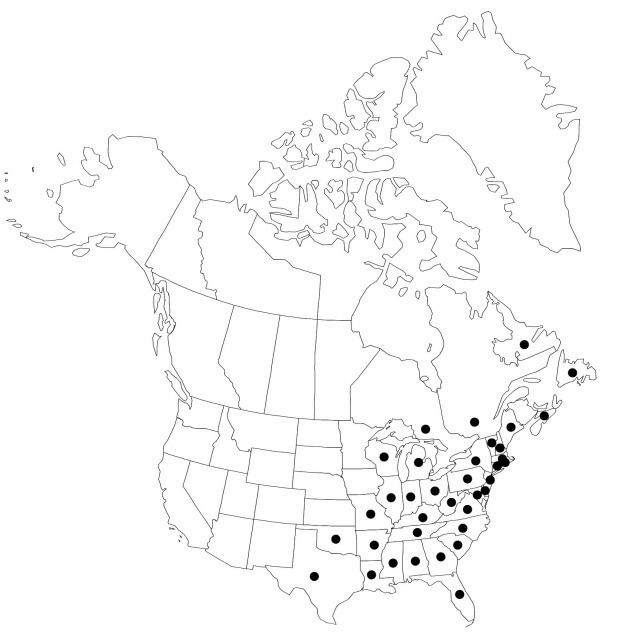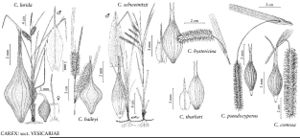Difference between revisions of "Carex lurida"
Kongl. Vetensk. Acad. Nya Handl. 24: 153. 1803.
FNA>Volume Importer |
imported>Volume Importer |
||
| (3 intermediate revisions by 2 users not shown) | |||
| Line 8: | Line 8: | ||
}} | }} | ||
|common_names=Carex luisant | |common_names=Carex luisant | ||
| + | |special_status={{Treatment/ID/Special_status | ||
| + | |code=F | ||
| + | |label=Illustrated | ||
| + | }} | ||
|basionyms= | |basionyms= | ||
|synonyms= | |synonyms= | ||
| Line 23: | Line 27: | ||
|habitat=Wet meadows, marshes, seeps, shores of ponds, lakes, and streams, open swamp forests, ditches, mostly in acidic, often sandy soils | |habitat=Wet meadows, marshes, seeps, shores of ponds, lakes, and streams, open swamp forests, ditches, mostly in acidic, often sandy soils | ||
|elevation=0–1200 m | |elevation=0–1200 m | ||
| − | |distribution=Nfld. | + | |distribution=Nfld. and Labr.;N.S.;Ont.;Que.;Ala.;Ark.;Conn.;D.C.;Fla.;Ga.;Ill.;Ind.;Ky.;La.;Maine;Md.;Mass.;Mich.;Miss.;Mo.;N.H.;N.J.;N.Y.;N.C.;Ohio;Okla.;Pa.;R.I.;S.C.;Tenn.;Tex.;Vt.;Va.;W.Va.;Wis.;Mexico;West Indies;South America. |
|discussion=<p><i>Carex lurida</i> is an abundant, variable, and often weedy species. A few specimens appear to be hybrids of <i>C. lurida</i> with <i>C. lupulina</i>.</p> | |discussion=<p><i>Carex lurida</i> is an abundant, variable, and often weedy species. A few specimens appear to be hybrids of <i>C. lurida</i> with <i>C. lupulina</i>.</p> | ||
|tables= | |tables= | ||
| Line 33: | Line 37: | ||
-->{{#Taxon: | -->{{#Taxon: | ||
name=Carex lurida | name=Carex lurida | ||
| − | |||
|authority=Wahlenberg | |authority=Wahlenberg | ||
|rank=species | |rank=species | ||
| Line 43: | Line 46: | ||
|habitat=Wet meadows, marshes, seeps, shores of ponds, lakes, and streams, open swamp forests, ditches, mostly in acidic, often sandy soils | |habitat=Wet meadows, marshes, seeps, shores of ponds, lakes, and streams, open swamp forests, ditches, mostly in acidic, often sandy soils | ||
|elevation=0–1200 m | |elevation=0–1200 m | ||
| − | |distribution=Nfld. | + | |distribution=Nfld. and Labr.;N.S.;Ont.;Que.;Ala.;Ark.;Conn.;D.C.;Fla.;Ga.;Ill.;Ind.;Ky.;La.;Maine;Md.;Mass.;Mich.;Miss.;Mo.;N.H.;N.J.;N.Y.;N.C.;Ohio;Okla.;Pa.;R.I.;S.C.;Tenn.;Tex.;Vt.;Va.;W.Va.;Wis.;Mexico;West Indies;South America. |
|reference=None | |reference=None | ||
|publication title=Kongl. Vetensk. Acad. Nya Handl. | |publication title=Kongl. Vetensk. Acad. Nya Handl. | ||
|publication year=1803 | |publication year=1803 | ||
| − | |special status= | + | |special status=Illustrated |
| − | |source xml=https:// | + | |source xml=https://bitbucket.org/aafc-mbb/fna-data-curation/src/2e0870ddd59836b60bcf96646a41e87ea5a5943a/coarse_grained_fna_xml/V23/V23_946.xml |
|genus=Carex | |genus=Carex | ||
|section=Carex sect. Vesicariae | |section=Carex sect. Vesicariae | ||
Latest revision as of 20:44, 5 November 2020
Plants densely to loosely cespitose; rhizomes short, no more than 10 cm. Culms sharply trigonous in cross section, (15–)25–95(–110) cm, scabrous-angled distally. Leaves: basal sheaths reddish purple; ligules as wide to slightly longer than wide; blades dark green, flat to W-shaped, widest leaves (4–)4.5–11.5(–13) mm wide, glabrous. Inflorescences 2.7–18 cm; proximal bract 9–45 cm, exceeding inflorescence; proximal 1–3(–4) spikes pistillate, erect or the proximal often spreading, (12–)15–22 mm thick, if spikes less than 15 mm thick, then usually less than 2.5 times as long as wide; terminal 1 spike staminate. Pistillate scales narrowly oblong, 3.4–11.2 × 0.5–1.1 mm, as long as or shorter than perigynia, margins often ciliate, apex truncate to retuse, erose, prolonged to scabrous awn. Staminate scales with distinct, scabrous awn, sometimes ciliate-margined. Perigynia spreading, strongly 7–12-veined, veins separate nearly to beak apex, broadly ovate, (6–)6.5–10.8 × (1.8–)2–3.5(–4.2), apex contracted; beak 2.5–5.9 mm, 0.7–0.9 length of body, bidentate, smooth, teeth straight, to 0.2–0.8 mm. Stigmas 3. Achenes yellow to brown, trigonous, papillose.
Phenology: Fruiting May–Aug.
Habitat: Wet meadows, marshes, seeps, shores of ponds, lakes, and streams, open swamp forests, ditches, mostly in acidic, often sandy soils
Elevation: 0–1200 m
Distribution

Nfld. and Labr., N.S., Ont., Que., Ala., Ark., Conn., D.C., Fla., Ga., Ill., Ind., Ky., La., Maine, Md., Mass., Mich., Miss., Mo., N.H., N.J., N.Y., N.C., Ohio, Okla., Pa., R.I., S.C., Tenn., Tex., Vt., Va., W.Va., Wis., Mexico, West Indies, South America.
Discussion
Carex lurida is an abundant, variable, and often weedy species. A few specimens appear to be hybrids of C. lurida with C. lupulina.
Selected References
None.
